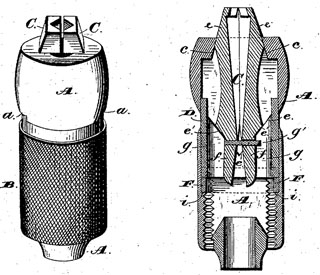Here's
a brace whose maker just couldn't stop trying to improve. There
are at
least three John Chantrell patents for the ratchet mechanism: 286,683
(page 1); 302,320, and 328,649. The three
different arrangements are shown at the lower right, below. Even so, the actual ratchet selector doesn't look like any
of them. There are also three
patents
that pertain to more or less degree to the chuck: 284,275;
see also 286,683
(page 2), and 302,648.

The patent and maker information for this
brace came partly from the Directory of American Toolmakers,
edited by the late Robert E. Nelson and published by the Early American Industries Association,
1999, and partly from Ron Pearson's fine book, The American Patented Brace, 1829-1924,
Astragal Press, Mendham, New Jersey, 1994, easily browsable as an occasionally updated
database at the Early American
Industries Association website.
|




The chuck operates by rotating back on the knurled shell, inseting the
bit, and then screwing the shell forward to lock the mechanism.
Luckily, no one was tempted to attempt to hold any straight-shank bits
by tightening this chuck's shell with a pipe wrench, as so often
happened with Barber's Improved chucks. Nevertheless, this
brace's selector has lost its original thumb-pins, now replaced with
soldered-on bumps.

 

Note how the ratchet wheel
is held below:


|









